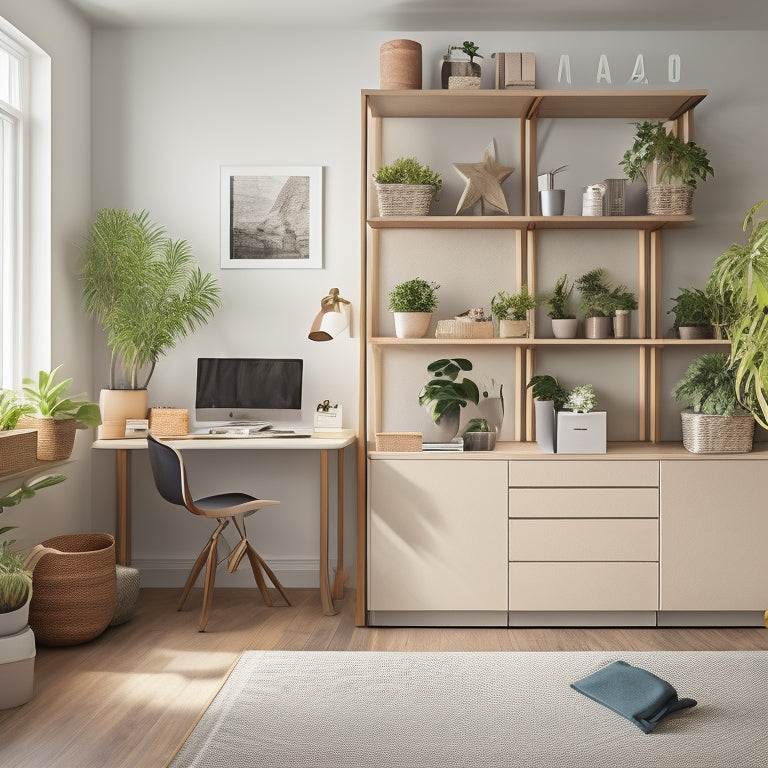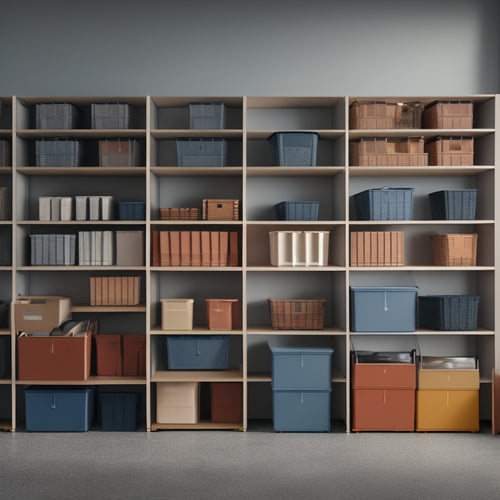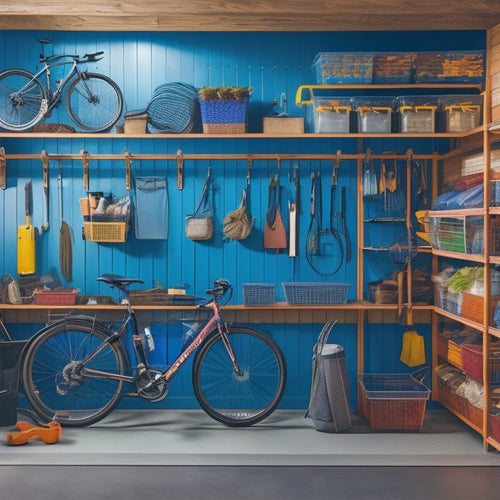
Organize Your Compact Space With These Proven Systems
Share
You can optimize your compact space by utilizing proven systems that maximize storage and productivity. Start by maximizing vertical storage space with hanging planters, floating shelves, and wall-mounted hooks. Customizable tool board systems let you tailor storage to your specific needs, while compact shelving and bins keep items organized and out of sight. Pegboard accessories, tool chest organization ideas, and ceiling storage options offer additional solutions. Finally, space-saving workbench solutions keep your workspace clutter-free. By implementing these systems, you'll be able to create a more efficient and organized space that works for you – and discover even more ways to make the most of your compact area.
Key Takeaways
• Maximize vertical storage space with hanging planters, floating shelves, and wall-mounted hooks to free up floor and surface space.
• Implement customizable tool board systems with pegboard, slatwall, and hooks to tailor storage to specific needs and easily identify tools.
• Utilize compact shelving and bins to store small items, and attach hanging baskets for extra storage in tight areas.
• Optimize corner areas with corner shelves, hanging organizers, and tiered shelves to create openness and organization.
• Label and categorize storage bins and shelves with clear signs and color-coded systems to ensure quick identification and access.
Maximizing Vertical Storage Space
Maximizing Vertical Storage Space
You can access a wealth of storage potential by utilizing your compact space's often-overlooked vertical real estate. By doing so, you'll free up valuable floor and surface space, making your area feel less cluttered and more organized.
One effective way to maximize vertical storage is by using hanging planters. Not only will they add a touch of greenery to your space, but they'll also keep your plants off the floor, keeping them out of the way.
Another option is to install floating shelves, which can be used to store books, decorative items, or even kitchen utensils. These shelves are perfect for small, narrow spaces and can be easily installed without taking up too much room.
Customizable Tool Board Systems
You can take your compact space's organization to the next level by incorporating customizable tool board systems, which allow you to tailor your storage to your specific needs and preferences. With a customizable layout, you can assign a designated spot for each tool, ensuring that everything has its place and is easily accessible. This not only saves time but also reduces clutter and frustration.
Customizable tool board systems typically consist of a pegboard or slatwall with hooks, bins, and holders that can be rearranged as needed. This flexibility is particularly useful in compact spaces where storage needs may change frequently.
By organizing your tools in a logical and visual manner, you can quickly identify what you need and where it's located. This efficient tool organization also enables you to identify gaps in your toolkit, making it easier to plan for future purchases.
Compact Shelving and Bins
Now that you've optimized your tool board, it's time to turn your attention to compact shelving and bins.
You'll want to make the most of your space by maximizing vertical storage and utilizing those often-wasted corner areas.
Maximize Vertical Storage Space
By installing compact shelving units that stretch from floor to ceiling, you can capitalize on the often-wasted vertical space in your compact area. This allows you to store more items without taking up valuable floor space.
Consider adding hanging planters or wall-mounted hooks to maximize storage capacity. These can be used to hang items like bikes, tools, or accessories, keeping them organized and out of the way.
Floating shelves are another great option for vertical storage. They can be used to display decorative items or store books, linens, or kitchen utensils.
Hanging baskets can also be attached to the walls or shelves to store smaller items like toys, cleaning supplies, or office materials.
By utilizing vertical space, you can create a sense of openness and airiness in your compact area, making it feel more spacious and organized.
With a little creativity, you can turn your compact space into a functional and efficient oasis.
Utilize Corner Areas Wisely
Corner areas, often dead zones in compact spaces, can be transformed into functional storage hubs with strategically placed compact shelving and bins. By utilizing these areas wisely, you can create additional storage space and keep your belongings organized.
Here are some ways to make the most of your corner areas:
-
Install corner shelves: These can hold baskets, bins, or small items like books, decorative items, or kitchen utensils.
-
Use hanging organizers: Over-the-door or wall-mounted hanging organizers can store items like cleaning supplies, linens, or accessories.
-
Opt for tiered corner shelves: These provide multiple levels of storage, perfect for storing items of varying sizes.
- Choose compact bins and baskets: Select bins and baskets that fit snugly into corner spaces, keeping items hidden from view while maintaining easy access.
Label and Categorize Bins
To guarantee easy access and visibility, categorize and label each bin according to its contents, so you can quickly find what you need. This simple step will save you time and energy in the long run. By categorizing and labeling your bins, you'll be able to see at a glance what's inside, making it easier to grab what you need and go.
Here are some tips to get you started:
| Category | Labeling Tips |
|---|---|
| Office Supplies | Use a bright blue label for office supplies, and consider sub-labeling for specific items like paper, pens, and staples. |
| Crafting Materials | Choose a vibrant pink label for crafting materials, and sub-label for different types of fabric, yarn, or paint. |
| Kitchen Essentials | Opt for a bold green label for kitchen essentials, and sub-label for baking supplies, cooking utensils, and snacks. |
| Personal Care Items | Select a calming purple label for personal care items, and sub-label for skincare, haircare, and makeup. |
Pegboard Accessories for Small Areas
You can maximize your compact space's storage potential with pegboard accessories specifically designed for small areas, which offer a versatile and customizable solution. These accessories are perfect for small space solutions, providing a pegboard organization system that can be tailored to your unique needs.
To get started, consider the following pegboard accessories:
-
Hooks: Ideal for hanging items like baskets, bins, and tools, hooks are a great way to utilize vertical space and keep frequently used items within easy reach.
-
Baskets: Perfect for storing small items like screws, nuts, or bolts, baskets can be easily attached to your pegboard and labeled for quick identification.
-
Shelves: Add extra storage space with shelves that can be mounted to your pegboard, providing a convenient spot for storing larger items.
- Tool holders: Keep your tools organized and within easy reach with tool holders specifically designed for your pegboard.
Tool Chest Organization Ideas
Now that you've optimized your pegboard, it's time to tackle your tool chest. To maximize the space inside, you'll want to develop a solid tool storage strategy, use chest drawer dividers to keep items separated, and implement a clear labeling and signage system.
Tool Storage Strategies
Effective tool storage strategies start with a well-organized tool chest, where every tool has its designated place, making it easy to find what you need in a flash. This not only saves you time but also reduces frustration and increases productivity.
To achieve this, consider the following tool storage strategies:
-
Hanging hooks solutions: Install hooks on the walls or inside your tool chest to hang tools like hammers, wrenches, and pliers, keeping them off the floor and out of the way.
-
Magnetic tool holders: Use magnetic strips or blocks to store small metal tools like screwdrivers, pliers, and wrenches, keeping them organized and within reach.
-
Rolling cart organization: Invest in a rolling cart or workbench with built-in storage to keep your tools and supplies mobile and easily accessible.
- Portable tool storage: Use portable cases or bags to store tools and supplies, making it easy to transport them to different work sites or projects.
Chest Drawer Dividers
By incorporating chest drawer dividers into your tool chest organization, you can create separate compartments for specific tools and supplies, making it easier to locate what you need at a glance. This is especially useful for small, frequently used items like screwdrivers, pliers, and wrenches, which can get lost in a cluttered drawer. With dividers, you can assign a specific space for each type of tool, keeping them organized and within reach.
Think of it like a drawer organizer for your clothing storage - you wouldn't store your socks and shirts together, would you? The same principle applies to your tool chest. By separating your tools into distinct categories, you'll save time searching for what you need and reduce frustration. Plus, dividers can help prevent tools from getting damaged or tangled, extending their lifespan.
Labeling and Signage
Take your tool chest organization to the next level by assigning clear labels and signs to each compartment, ensuring you can quickly identify where specific tools and supplies are stored. This simple yet effective step will save you time and frustration when searching for a particular item.
Here are some tips to help you get started with labeling and signage:
-
Use a color coded organization system to categorize tools and supplies by type or project, making it easy to find what you need at a glance.
-
Implement clear container labeling to identify what's inside each container without having to open it.
-
Use signs to indicate the contents of each drawer or shelf, and consider adding a picture or icon to help with visual recognition.
- Consider using a label maker or chalkboard labels to make it easy to update and change labels as needed.
Utilizing Ceiling Storage Options
You can reclaim lost space in your compact home or apartment by maximizing your ceiling's storage potential. By utilizing overhead racks and hanging baskets, you can store items that are less frequently used, freeing up valuable floor and shelf space.
Overhead racks are perfect for storing large, bulky items like luggage, camping gear, or out-of-season decorations. You can install them in your garage, attic, or even in a closet.
Hanging baskets are another great option for ceiling storage. They're ideal for storing smaller items like linens, toys, or cleaning supplies. Look for baskets with sturdy hooks or chains that can hold a decent amount of weight. You can hang them from the ceiling in your closet, laundry room, or even in a hallway.
Space-Saving Workbench Solutions
Five clever space-saving workbench solutions can help transform your compact workshop or DIY area into a functional haven. By implementing these solutions, you'll be able to maximize your limited space and increase productivity.
Here are some space-saving workbench solutions to explore:
-
Wall-mounted solutions: Install a wall-mounted workbench or pegboard to keep frequently used tools within easy reach. This will help keep your workspace clear and organized.
-
Folding workbenches: Invest in a folding workbench that can be easily stowed away when not in use. This is perfect for small workshops or DIY areas with limited floor space.
-
Compact workstations: Opt for a compact workstation with built-in storage, such as drawers or shelves, to keep your workspace organized and clutter-free.
- Drawer organizers: Use drawer organizers to maximize the storage capacity of your workbench drawers. This will help keep your tools and materials neatly organized and easily accessible.
Frequently Asked Questions
How Do I Maintain Organization Systems Over Time?
"You're not alone: 80% of people struggle to maintain organization systems. To succeed, prioritize time management, regularly declutter, and implement storage maintenance routines, ensuring your organization tips stick and your space remains clutter-free over time."
Can I Customize Systems for Left-Handed People?
You can definitely customize systems for left-handed individuals by incorporating left-handed adaptations and ergonomic solutions that cater to their unique needs, ensuring comfort and efficiency in their daily routines.
Are There Eco-Friendly Storage Solutions Available?
You'll find many eco-friendly storage solutions that cater to your green organization needs, offering sustainable options like upcycled materials, space-saving solutions, and recycled products to help you live more environmentally conscious.
How Do I Organize Awkwardly Shaped Tools and Items?
"You've mastered the art of storing rectangular boxes, but those awkwardly shaped tools and items are still a puzzle, right? Try maximizing vertical storage with stackable shelves or utilizing magnetic strips to keep them tidy and accessible."
Can I Use These Systems in Non-Traditional Workspaces?
You can repurpose these organizing systems in non-traditional workspaces, like a home office or tiny apartment, to maximize space and boost productivity, allowing you to focus on serving others.
Related Posts
-

Heavy-Duty Pegboard Hooks for Industrial Use
You need heavy-duty pegboard hooks that can withstand the rigors of industrial use, providing a reliable and efficien...
-

Choosing the Right Stacked Storage Bins
When choosing the right stacked storage bins, you'll want to evaluate your storage needs, considering inventory types...
-

Garage Wall Storage Ideas to Boost Productivity
You can enhance your garage's productivity by capitalizing on your ceiling height with overhead racks, storing bulky ...


